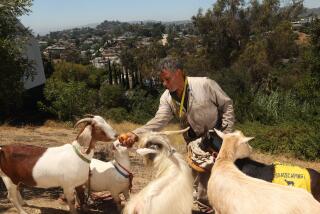Wild Goat Slaughter Is Delayed Again
- Share via
In what an animal rights leader called “an amazing and most exciting” decision, Navy officials in Washington said Tuesday they would indefinitely postpone plans to slaughter the wild goats of San Clemente Island and would allow resumption of a trapping program sometime this summer.
The slaughter by gunfire had been set to start at dawn Thursday.
Cleveland Amory, author and head of the New York-based Fund for Animals, said, “This was a decision that came from within the Navy itself and indicates they are interested in rescuing rather than shooting the goats and that they are aware of the bad public relations” created by killing the animals.
The Navy has argued that it has to remove the wild animals from the island, largely used for bombing practice, to comply with the Endangered Species Act of 1973. The goats have been blamed for eating certain plants and ruining the habitat of several species of birds and animals on the endangered species list.
It was the fourth time since 1979 that plans to shoot the island’s wild goats have been called off at the last minute. The last time, in January, Secretary of Defense Caspar W. Weinberger intervened at the request of the Fund for Animals and allowed the organization to carry out the rescue operation, which began in early February and ended Monday.
At that time, there were an estimated 1,200 to 1,500 goats on the Navy-owned island, 60 miles off the coast of San Diego. Amory said that as of Monday, a team of trappers firing a net from a helicopter had brought in 870 animals.
“The success of this operation undoubtedly impressed the Navy and was part of a very reasonable proposal that our attorney, Dana Cole, made to them,” he said.
The decision was announced in a statement by the Navy’s information office in Washington. It said, in part, that not only will the Fund for Animals be granted additional time for netting goats during the summer when the island is not being used for military bombing operations, but it also will be allowed to enter the shore bombardment area where many of the goats take refuge. Access to that part of the island had been restricted because of the danger posed by undetonated bombs and shells.
The Fund for Animals will assume full responsibility for rescue teams entering that zone, the statement said.
The statement made no direct mention of halting the shooting, but Cole said he had been informed earlier by Richard Cornelius, associate general counsel for the Navy in Washington, that the slaughter had been postponed indefinitely.
Amory said the success of the netting operation was due to the rescue team of Bill Hales, a New Zealander who developed the netting technique used to capture the goats; helicopter pilot Mel Cain of San Diego, and Fund for Animal member Donna Gregory.
“They brought back 870 live goats,” he said. “Five hundred of those already have been adopted by private individuals from our sanctuaries in California.”
More to Read
Sign up for Essential California
The most important California stories and recommendations in your inbox every morning.
You may occasionally receive promotional content from the Los Angeles Times.













